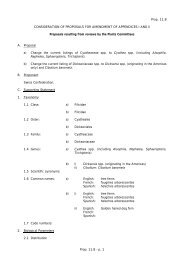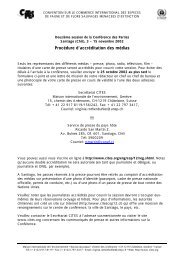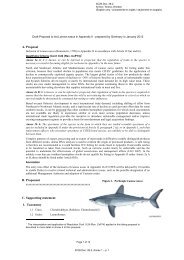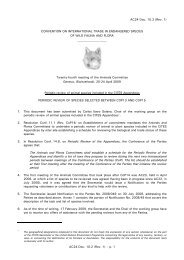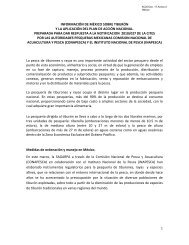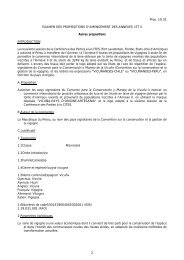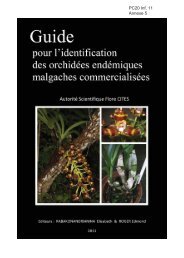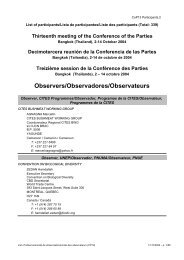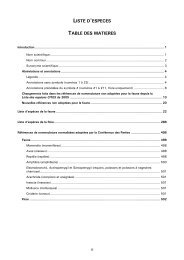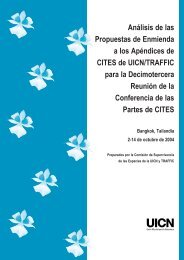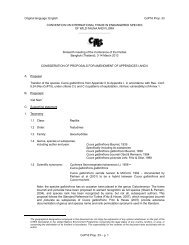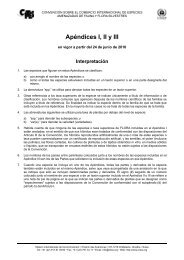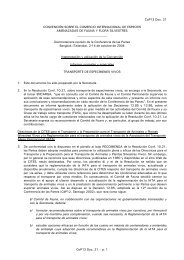Lynx rufus - Cites
Lynx rufus - Cites
Lynx rufus - Cites
You also want an ePaper? Increase the reach of your titles
YUMPU automatically turns print PDFs into web optimized ePapers that Google loves.
A. PROPOSAL<br />
CONVENTION ON INTERNATIONAL TRADE IN ENDANGERED SPECIES<br />
OF WILD FAUNA AND FLORA<br />
Amendments to Appendices I and II of CITES<br />
Thirteenth Meeting of the Conference of the Parties<br />
Bangkok (Thailand), 2 – 14 October 2004<br />
Deletion of bobcat (<strong>Lynx</strong> <strong>rufus</strong>) from Appendix II.<br />
B. PROPONENT<br />
United States of America.<br />
C. .SUPPORTING STATEMENT<br />
1.1 Taxonomy<br />
1.1 Class: Mammalia<br />
1.2 Order: Carnivora<br />
1.3 Family: Felidae<br />
1.4 Species: <strong>Lynx</strong> <strong>rufus</strong>, Lapham 1852<br />
Potential subspecies: L. r. baileyi, L. r. californicus, L. r. escuinapae, L. r. fasciatus, L. r.<br />
floridanus, L. r. gigas, L. r. oaxacensis, L. r. pallescens, L. r. peninsularis, L. r. <strong>rufus</strong>, L. r.<br />
superiorensis, L.r. texensis. Hall 1981.<br />
1.5 Scientific synonyms<br />
Felis <strong>rufus</strong>, Jones et al. 1975, Tumlison 1987, Nowak 1999<br />
Common names (Jackson 1961, Banfield 1987, McCord and Cardoza 1982)<br />
English: bobcat, barred bobcat, bay lynx, bob-tailed cat, cat o’ the mountain, cat lynx,<br />
catamount, lynx cat, pallid bobcat, red lynx, wildcat<br />
French: chat sauvage, chat sauvage de la nouvelle cosae, loup-cervier, lynx roux, pichou,<br />
pichu<br />
Spanish: gato de monte<br />
1.7 Code Numbers: A-112.007.001.024<br />
2. Biological Parameters<br />
2.1 Distribution<br />
The bobcat is the most widely distributed native felid in North America, ranging from as far<br />
north as central British Columbia (55°N) and south to Oaxaca, Mexico (17°N). Currently, with<br />
the exception of Delaware, the bobcat can be found in all the contiguous United States;<br />
however, its distribution is restricted in Illinois, Indiana, Iowa, Michigan, Missouri, and Ohio<br />
1<br />
1.6
(Woolf and Hubert 1998). Historically the bobcat was found in all 48 states (Young 1958).<br />
During the last century, its range expanded into northern Minnesota, southern Ontario, and<br />
Manitoba as lumbering, fire, and farming opened the dense, unbroken coniferous forests of<br />
these areas (Rollings 1945). Further expansion into human-influenced landscapes has been<br />
noted during the past decade, particularly in the midwestern and eastern United States (Woolf<br />
and Neilson 2001).<br />
There are 12 potentially valid subspecies of the bobcat in North and Central America (Hall<br />
1981). However, a detailed morphological study of bobcat skulls from the south-central<br />
United States led Read (1981) to suspect that there were far fewer valid intra-specific taxa<br />
than Hall (1981) had recognized, since the bobcat is fairly continuous in its distribution with no<br />
clear geographic breaks. McCord and Cardoza (1982) suggested that the differences between<br />
subspecies are so minor that they have no real biological or managerial significance. They<br />
questioned the biological significance and validity of L. r. escuinapae of central Mexico. The<br />
subspecies was described from two immature male specimens on the basis of color and cranial<br />
differences (Allen 1903). A multivariate statistical analysis of a variety of skull measurements<br />
has indicated that cranial characteristics of L. r. escuinapae are similar to those of L. r.<br />
californicus and L.r. texensis (Samson 1979). Also, the range of L. r. escuinapae overlaps with<br />
that of L. r. baileyi and L.r. texensis.<br />
2.2 Habitat availability<br />
Bobcats are found in a wide variety of habitats, from bottomland forests in Alabama to arid<br />
deserts in Mexico, and from northern boreal forests in Canada to the humid tropical regions of<br />
Florida. They generally prefer rough, rocky country interspersed with dense cover (Pollack<br />
1951b, Erickson 1955, Young 1958, Zezulak and Schwab 1979, Karpowitz 1981, Golden<br />
1982). McCord (1974) snow-tracked bobcats in Massachusetts and found that roads, cliffs,<br />
spruce plantations, and hemlock-hardwoods were used most in relation to their abundance. He<br />
attributed the use of hemlock-hardwoods to high white-tailed deer (Odocoileus virginianus)<br />
(prey) densities and use of spruce plantations to abundant snowshoe hare (Lepus americanus)<br />
(prey) and protection from the wind. Similarly, Fuller et al. (1985a) in Minnesota found a<br />
disproportionate use of coniferous areas, which also supported the highest density of<br />
snowshoe hares and white-tailed deer, the bobcats' main prey in that region. Bobcats in<br />
Missouri preferred bluffs, brushy fields, and second-growth oak habitats (Hamilton 1982).<br />
Bluffs were apparently selected for social reasons as well as the physiological advantages of<br />
cover, whereas brushy fields and areas of oak regeneration offered high densities of prey. In<br />
Wisconsin, lowland coniferous forests were consistently selected by both sexes during all<br />
seasons, although there were sex-related and seasonal differences in selection of other<br />
habitats (Lovallo and Anderson 1996). In Mexico, bobcats are found in dry scrub, coniferous<br />
forests, mixed forests of pine and oak, and tropical deciduous forests (27 April 2004 letter to<br />
K. Stansell, Assistant Director, International Affairs, U.S. Fish and Wildlife Service from H.<br />
Benítez Díaz, Director of Outreach and International Affairs, National Commission for the<br />
Understanding and Use of Biodiversity, Mexico).<br />
Although prey abundance is considered the most important factor in the selection of habitat<br />
types, protection from severe weather, availability of resting and denning sites, dense cover for<br />
hunting and escape, and freedom from disturbance are also important factors in determining<br />
habitat use (Pollack 1951b, Erickson 1955, Bailey 1974). Knowles (1985) found that bobcats<br />
in Montana generally selected habitat types with 52% or greater vertical cover. Although prey<br />
densities were highest in those types, she felt that cover was crucial for the bobcat’s effective<br />
hunting by ambush and stalking. Similarly, Lovallo (1999) in Pennsylvania found that bobcats<br />
2
were strongly associated with eastern to southeastern exposures on 7-8° slopes. McCord<br />
(1974) felt that behavioral factors, such as hunting habits or social interactions, also dictate<br />
the temporal and spatial use of habitat types.<br />
2.3 Population status<br />
The U.S. Fish and Wildlife Service (USFWS) estimated that, in 1988, bobcat population size in<br />
the United States was from 700,000 to 1,500,000 adult resident animals (Turbak 1988).<br />
Geographic expansion of bobcat range and notable increases in bobcat density during the past<br />
decade suggest that population size has likely increased since these estimates were produced<br />
(Woolf and Hubert 2001, Lovallo 2001). Numerous States independently estimate bobcat<br />
populations by using a variety of methods, such as computer population models and life table<br />
analyses (Anderson and Lovallo 2003). Bobcat populations in Canada and Mexico are reported<br />
as widespread and generally healthy (Government of Canada 1983, United States Government<br />
1992). Bobcats are described as abundant throughout many regions of Mexico, including<br />
developed areas of the southern and central portions of the country (27 April 2004 letter from<br />
H. Benítez Díaz).<br />
2.4 Population trends<br />
As of 1996, populations in the United States were considered stable in 22 States and<br />
increasing in 20 States, with no States reporting overall declines (Woolf and Hubert 1998). As<br />
of 2001, several midwestern and eastern States continued to report population increases<br />
(Woolf and Neilson 2001). Mexican scientists have indicated that there have been no<br />
reductions in bobcat populations over the past 25 years (27 April 2004 letter from H. Benítez<br />
Díaz).<br />
2.5 Geographic trends<br />
Periodic national surveys of bobcat abundance and distribution suggest continued geographic<br />
expansion of bobcat populations throughout their range in the United States, particularly in<br />
Midwestern and several mid-Atlantic States (Hon 1990, Woolf and Neilson 2001). Most<br />
notably, bobcat populations have expanded their ranges in Illinois (Bluett et al. 2001, Woolf<br />
and Hubert 1998), Missouri (Erickson et al. 2001), Nebraska (Lendholt and Genoways 2000),<br />
and Pennsylvania (Lovallo 2001), as well as Indiana, Michigan, and Ohio (Woolf and Hubert<br />
1998).<br />
2.6 Role of the species in its ecosystem<br />
Bobcats are one of several carnivores within the complex predator communities of North<br />
America. Because bobcats occupy a wide variety of habitats, their role as forest and farmland<br />
predators is varied. Although bobcats compete with other predators, there is no evidence that<br />
other predator species populations are directly related to bobcat density on the landscape.<br />
Bobcats are ecologically similar to Canadian lynx, particularly in terms of prey selection, and<br />
their ranges are rarely sympatric. Where bobcat and lynx ranges overlap, bobcat typically<br />
outcompete lynx unless excessive snow depth provides lynx with a foraging advantage (Parker<br />
et al. 1983).<br />
2.7 Threats<br />
Although bobcats adapt to a wide variety of habitat conditions, loss of habitat to urbanization<br />
is the only significant threat to current populations. Woolf and Hubert (1998) suggested that<br />
3
ecent expansions of bobcat populations in the Midwest have resulted from increased<br />
forestation during recent decades. The bobcat is not listed in the 2003 IUCN Red List of<br />
Threatened Species (IUCN 2003).<br />
3. Utilization and Trade<br />
3.1 National utilization<br />
Bobcats are legally harvested in 38 U.S. States as well as regions of Canada and Mexico.<br />
Bobcat harvests in North America have varied due to changes in pelt value and fur harvest<br />
intensity for other species. Although bobcat harvests increased during 1976-1984, recent<br />
harvest levels in the United States have been comparable to those observed prior to CITES<br />
listing (34,937 harvested during 1995-1996 versus 35,937 harvested during 1975-1976).<br />
Woolf and Hubert (1998) concluded that, based on harvest-associated data, it was unlikely<br />
that bobcat populations were reduced during high harvest years; rather, these populations<br />
were thought to have remained stable.<br />
3.2 Legal international trade<br />
According to World Conservation Monitoring Centre (WCMC) data, between 1998 and 2002,<br />
there were 118,929 specimens exported. The majority of the exports originated from range<br />
countries. However, only 9 specimens originated from Mexico. Non-range countries or<br />
unknown sources accounted for 0.5% of exports (World Conservation Monitoring Centre<br />
2003; Table 1).<br />
Table 1. Number of specimens of <strong>Lynx</strong> <strong>rufus</strong> in international trade exported between 1998<br />
and 2002.<br />
3.3 Illegal trade<br />
Year<br />
1998<br />
1999<br />
2000<br />
2001<br />
2002<br />
Total<br />
Specimens exported from the<br />
Canada, Mexico, or the<br />
United States<br />
4<br />
Specimens exported from<br />
non-range countries or of<br />
unknown origin<br />
17,397 3<br />
20,454 44<br />
15,925 1<br />
34,287 0<br />
30,269 549<br />
118,332 597<br />
According to U.S. Fish and Wildlife Service Law Enforcement databases, from 1998 to 2004,<br />
there were 174 <strong>Lynx</strong> <strong>rufus</strong> specimens seized by law enforcement agents.<br />
3.4 Actual or potential trade impacts
Neither domestic nor international trade constitutes a threat for populations of the bobcat.<br />
3.5 Captive breeding or artificial propagation for commercial purposes (outside country of origin)<br />
Some States allow and regulate captive rearing and propagation of bobcats for commercial<br />
purposes. However, current international trade of bobcat pelts is dominated by wild fur<br />
harvests from North American countries.<br />
4. Conservation and Management<br />
4.1 Legal status<br />
4.1.1 National<br />
Bobcat hunting and trade is regulated domestically throughout its range (Nowell and<br />
Jackson 1996). In the United States, bobcats are currently classified as game or<br />
furbearer species and subsequently harvested through regulation in 38 States. The<br />
species is further protected by continuous closed hunting seasons in 9 States and is<br />
classified as a State endangered species in Indiana, Ohio, New Jersey, and Iowa.<br />
Bobcats are classified and protected as a State threatened species in Illinois.<br />
In Mexico, bobcat hunting is regulated in 5 States, and shooting suspected livestock<br />
predators is permitted on a limited basis (Nowell and Jackson 1996). In Canada,<br />
bobcat hunting is also regulated.<br />
4.1.2 International<br />
Prior to COP8, all subspecies of bobcats except <strong>Lynx</strong> <strong>rufus</strong> escuinapae were included in<br />
Appendix II due to similarity of appearance (Article II, paragraph 2b) to other listed<br />
felids. L. r. escuinapae was listed in Appendix I, but due to the uncertainty of its<br />
validity as a subspecies, the United States successfully proposed its downlisting to<br />
Appendix II. Presently, the entire species is listed in Appendix II. Trade is not<br />
threatening this species with the possibility of extinction. In the United States, L. r.<br />
escuinapae is listed as endangered under the U.S. Endangered Species Act of 1973;<br />
however, this listing status is currently under review.<br />
4.2 Species management<br />
4.2.1 Population monitoring<br />
Although population size is difficult to estimate for bobcats due to their cryptic and<br />
primarily nocturnal behavior, numerous indices have been employed by State and<br />
provincial furbearer managers to determine range, occupancy of habitats, and<br />
geographic and numeric trends in bobcat populations. Examples of such data include<br />
but are not limited to collection of vehicle-caused mortalities, hunter and trapper<br />
questionnaires, geographically referenced harvest data, employee opinion, hunter<br />
sightings, archer sightings, incidental captures by trappers, scent-station surveys, and<br />
winter track counts (Anderson and Lovallo 2003).<br />
4.2.2 Habitat conservation<br />
5
Because bobcats thrive in a wide variety of habitats throughout their range, State and<br />
Federal acquisitions of these habitats are able to sustain the current distribution.<br />
4.2.3 Management measures<br />
4.3 Control measures<br />
The 38 States that allow bobcat harvest have implemented measures to control<br />
harvest intensity through regulations that dictate season length, methods of take, bag<br />
limits, and mandatory reporting. Additionally, many States use individual permits (9<br />
States) or statewide harvest quotas (4 States) to limit the annual harvest (Woolf and<br />
Hubert 1998). States periodically review species harvest programs to account for new<br />
findings and current advice from experts in their region. Commercial harvest of<br />
captive-bred animals is not common, but where legal, is monitored by state authorities.<br />
Sustainable harvest rates are most often determined by using population models or life<br />
table analyses based on population demographic data collected annually from<br />
harvested samples. Managers generally consider 20% to be the maximum sustainable<br />
harvest rate for bobcats, and age structure analyses, such as adult-to-yearling ratios,<br />
have been developed to estimate changes in harvest rates over time (Knick 1990).<br />
4.3.1 International trade<br />
In the United States, transport of bobcats among States and across international<br />
borders is controlled and enforced through the Lacey Act. State and Tribal CITES<br />
furbearer export programs in the United States must be approved by the U.S. Fish and<br />
Wildlife Service’s Division of Management Authority and Division of Scientific<br />
Authority. Minimum requirements are established for biological and management<br />
program information necessary for approval (48 Federal Register 37494, 18 August<br />
1983). Approved programs are monitored through submitted annual reports to the<br />
Service.<br />
4.3.2 Domestic measures:<br />
According to Nowell and Jackson (1996), the bobcat management programs in the<br />
United States and Canada are the most advanced management programs for<br />
commercial exploitation of feline furbearers. The management programs ensure longterm<br />
sustainable use of the species and support its conservation. State agencies<br />
employ qualified and specialized wildlife biologists to provide management and harvest<br />
recommendations for bobcats in their respective regions. Other scientists, agency<br />
personnel, and the public review management recommendations prior to adoption.<br />
State and Federal agency wildlife law enforcement personnel are trained to identify<br />
bobcats and are well versed in State and Federal law regarding the harvest, transport,<br />
and sale of bobcats and bobcat parts.<br />
5. Information on Similar Species<br />
Several species have been identified as similar in appearance to bobcat including Canada lynx<br />
(<strong>Lynx</strong> canadensis), Iberian lynx (<strong>Lynx</strong> pardinus), and Eurasian lynx (<strong>Lynx</strong> lynx). Although<br />
differentiation of spotted belly hair may be problematic, the pelage and skull can be used to clearly<br />
distinguish bobcats from other members of the genus <strong>Lynx</strong>. For example, Canada lynx can be<br />
distinguished visually from bobcats by their large furry pads, slightly shorter tail, longer black ear<br />
6
tufts and black margins along the ear (>2.5 cm), as well as a less defined spotting on the coat.<br />
The tail of the lynx is brownish or pale buff white and ends in a black tip that completely encircles<br />
the tail whereas the bobcat the tail is banded on the upper surface only (Lariviere and Walton<br />
1997). Also, the pelage of the lynx is generally grayer than the reddish-brown color of the bobcat.<br />
Bobcat skulls can be identified by the presence of both a narrow presphenoid bone (
Golden, H. 1982. Bobcat populations and environmental relationships in northwestern Nevada.<br />
Thesis, University of Nevada: Reno, Nevada.<br />
Government of Canada. 1983. Proposal for the deletion of the Canadian populations of bobcat,<br />
<strong>Lynx</strong> <strong>rufus</strong>, from Appendix II. Proceedings of the Fourth Conference of the Parties.<br />
Secretariat of CITES: Lausanne, Switzerland.<br />
Hall, E. R. 1981. The Mammals of North America. Wiley and Sons: New York.<br />
Hamilton, D. A. 1982. Ecology of the bobcat in Missouri. Thesis, University of Missouri:<br />
Columbia, Missouri.<br />
IUCN 2003. 2003 IUCN Red List of Threatened Species. IUCN: Gland, Switzerland.<br />
Jackson, H. H. T. 1961. Mammals of Wisconsin. University of Wisconsin Press: Madison,<br />
Wisconsin.<br />
Karpowitz, J. F. 1981. Home range and movements of Utah bobcats with reference to habitat<br />
selection and prey base. Thesis, Brigham Young University: Provo, Utah.<br />
Knowles, P. R. 1985. Home range size and habitat selection of bobcats, <strong>Lynx</strong> <strong>rufus</strong>, in northcentral<br />
Montana. Canadian Field Naturalist 99:6-12.<br />
Landholt, L. M. and H. H. Genoways. 2000. Population trends in furbearers in Nebraska.<br />
Transactions of the Nebraska Academy of Sciences 26:97-100.<br />
Lariveire, S. and L. R. Walton 1997. <strong>Lynx</strong> <strong>rufus</strong>. Mammalian Species 563:1-8.<br />
Lovallo, M. J. 1999. Multivariate models of bobcat habitat selection for Pennsylvania landscapes.<br />
Dissertation, Pennsylvania State University: University Park, Pennsylvania.<br />
Lovallo, M. J. 2001. Status and management of bobcat in Pennsylvania. Pages 74-79 in A.<br />
Woolf, C. K. Nielsen, and R. D. Bluett editors. Proceedings of a Symposium on Current Bobcat<br />
Research and Implications for Management. The Wildlife Society 2000 Conference: Nashville,<br />
Tennessee.<br />
Lovallo, M. J. and E. M. Anderson 1996. Bobcat (<strong>Lynx</strong> <strong>rufus</strong>) home range size and habitat use in<br />
northwest Wisconsin. American Midland Naturalist 135:241-252.<br />
McCord, C. M. 1974. Selection of winter habitat by bobcats (<strong>Lynx</strong> <strong>rufus</strong>) on the Quabbin<br />
Reservation, Massachusetts. Journal of Mammalogy 55:428-437.<br />
McCord, C. M and J. E. Cardoza. 1982. Bobcat and lynx (Felis <strong>rufus</strong> and F. lynx). Pages 728-<br />
766 in J. A. Chapman and G. A. Feldhamer, editors. Wild Mammals of North America:<br />
Biology, Management, and Economics. Johns Hopkins Press: Baltimore, Maryland.<br />
Nowell, K. and P. Jackson (compiler and eds.). 1996. Wild Cats: Status Survey and Action Plan.<br />
IUCN: Gland, Switzerland. Pp. 140-144.<br />
Ommundsen, P. D. 1991. Morphological differences between lynx and bobcat skulls. Northwest<br />
Science 65:248-250.<br />
8
Parker, G. R. and G. E. J. Smith 1983. Sex- and age-specific reproductive and physical<br />
parameters of the bobcat (<strong>Lynx</strong> <strong>rufus</strong>) on Cape Breton Island, Nova Scotia. Canadian Journal<br />
of Zoology 61:1771-1782.<br />
Pollack, E. M. 1951. Observations on New England bobcats. Journal of Mammalogy 32:356-<br />
358.<br />
Read, J. A. 1981. Geographic variation in the bobcat (Felis <strong>rufus</strong>) in the south-central United<br />
States. Thesis, Texas A & M University: College Stations, Texas, USA.<br />
Rollings, C. T. 1945. Habits, foods and parasites of the bobcat in Minnesota. Journal of Wildlife<br />
Management 9:131-145.<br />
Samson, F. B. 1979. Multivariate analysis of cranial characters among bobcats, with a<br />
preliminary discussion of the number of subspecies. Pages 80-86 in P. C. Escherich and L.<br />
Blum, editors. Proceedings of the 1979 Bobcat Research Conference. National Wildlife Federal<br />
Science and Technology Series 6.<br />
United States Government. 1994. Proposal to transfer Felis rufa escuinapae from Appendix I to<br />
Appendix II. Proceedings of the Eigth Meeting of the Conference of the Parties. Secretariat of<br />
CITES: Geneva, Switzerland.<br />
Woolf, A. and G. F. Hubert 1998. Status and management of bobcats in the United States over<br />
three decades: 1970’s-1990’s. Wildlife Society Bulletin 26:287:294.<br />
Woolf and Neilson. 2000.<br />
Young, S. P. 1958. The Bobcat of North America. Wildlife Management Institute: Washington,<br />
D.C.<br />
Zezulak, D. S. and R. G. Schwab. 1979. A comparison of density, home range, and habitat<br />
utilization of bobcat populations at Lava Beds and Joshua Tree National Monuments, California.<br />
Pages 74-79 in P. C. Escherich and L. Blum, editors. Proceedings of the 1979 bobcat research<br />
conference. National Wildlife Federal Science and Technology Series 6.<br />
9




